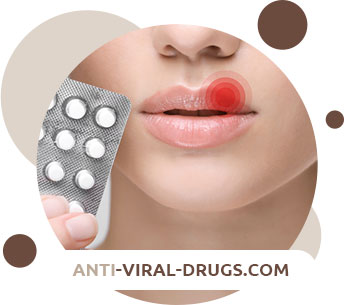

Herpes simple
Herpes simplex - herpes simplex or blister herpes has been known to mankind since ancient times, and the name “herpes” has a Greek origin - “crawl”, “sneak up”, which fully corresponds to the clinical manifestations of diseases caused by the herpes simplex virus (HSV). Diseases caused by the herpes simplex virus are quite common, some complications of the infection are fatal. Data from the US Centers for Disease Control register about half a million cases of herpes infection per year, from which it can be assumed that between 2 and 20 million Americans are carriers of herpes infection. In England, the increase in the incidence of herpes simplex infection of the genitals is higher than that of other sexually transmitted infections. In Scandinavian countries, herpes simplex is found in about 8% of women who see a venereologist. In our country, there are no statistics on the incidence of herpes, but herpes infection is widespread, as indicated by the data of private surveys on the carriage of the herpes simplex virus.
Relapse of herpes infection occurs in the case of reactivation of the virus, this is possible after hypothermia, overheating, with reduced immunity, in particular, herpes infection is a specific complication of HIV infection. Herpes virus serotype 1 rashes are usually located in the nasolabial region, the virus also manifests itself as keratoconjunctivitis, and HSV-2 rashes are localized in the genital area. But, given the peculiarities of sexual behavior, the localization of the rash can be exactly the opposite. Therefore, herpes requires serological tests to establish the serotype.
Etiology and pathogenesis
The group of herpes viruses includes 4 viruses similar in morphology: HSV (herpes simplex), varicella-zoster - the causative agent of shingles and chickenpox, Epstein-Barr virus and cytomegalovirus; in 1962, it was revealed that the herpes simplex virus has two serotypes - serotype 1 and serotype 2. Serological studies confirm that by the end of 18 months of life, almost every person had contact with HSV-1, the gateway, as a rule, is the respiratory tract. After that, the virus enters the cells of the trigeminal ganglion, but during life it may never cause clinical manifestations of infection.
With HSV-2, the first contact usually occurs during puberty at the onset of sexual relations. Moreover, after external manifestations, which may not exist, the virus also becomes inactive and can persist in the cells of the sacral ganglion for a long time.
Herpes simplex, especially of the second type, has oncogenic properties, which is of great importance given the prevalence of the infection. The incidence of herpes infection is approximately the same in all age groups and is equally common regardless of gender. Clinical manifestations also depend on the location and size of the lesion, as well as on the general state of the immune system.
Herpes manifestations
Herpes simplex is most often localized around the wings of the nose, the corners of the mouth, the red border of the lips and in the genital area, that is, around the natural openings. In one, less often in two or three places, small bubbles appear against the background of limited hyperemia; each focus contains from two to ten or more. The bubbles are arranged in a group and filled with transparent exudate, which becomes cloudy after a few days. In some cases, single bubbles merge to form several multi-chamber bubbles, which have an uneven scalloped edge and reach up to 1.5 cm in diameter.
When the process is localized, the bubbles on areas of the skin that are not subject to maceration and friction shrink into a yellowish-gray crust, which disappears on its own after 5-7 days. And in place of the bubble, a pigmented area remains, after some time it acquires a normal color.
On mucous membranes, as well as in those areas that are subject to maceration or friction, the bubbles open, as a result of which erosion of a polycyclic shape with a bright red bottom is formed. The rash is accompanied by a burning sensation, pain and a tingling sensation, if there are enough rashes, swelling of nearby tissues occurs. The general condition of the patient with an infection caused by the herpes simplex virus does not suffer, but in some cases chills, muscle pain and low-grade fever may occur. In general, the process lasts 10-14 days, with the addition of a secondary infection, the duration of the disease increases.
Herpes simplex virus can cause herpetic stomatitis, the clinical manifestations of which are lesions of the mucous membranes of the mouth, lips, cheeks, gums and palate. Small groups of small vesicles appear on the swollen and hyperemic mucous membrane. The bubbles open up in the first few hours, leaving erosion, which, due to the confluence, have small-fistula outlines. After 2-4 days, erosion is covered with a delicate fibrous film, and then epithelialized. Herpetic stomatitis, not complicated by other infections, lasts 6-14 days, the general condition of the patient is satisfactory, but there is pain in the oral cavity and hypersalivation.
In children of younger and preschool age, the herpes virus most often causes acute aphthous stomatitis. During a short prodromal period, general malaise, weakness, loss of appetite, and a slight increase in body temperature are noted. The mucous membrane of the oral cavity is sharply edematous and hyperemic, and aphtoid-like rashes are localized everywhere. Unlike simple stomatitis, the rashes are in the form of aphthae with an area of necrosis in the center and a pronounced inflammatory rim along the periphery, the diameter of single rashes is up to 1 cm.As the process progresses, the aphthae merge and form extensive erosive and ulcerative areas with uneven edges. Hypersalivation, loss of appetite, fever and severe pain are noted.
In some patients, relapses of herpes infection are possible, depending on the seasonality or without connection with the season; with reduced immunity, relapses can occur several times a month. The clinical manifestations of recurrent herpes depend on the localization, the general condition of the patient, but do not differ from the manifestations of herpes simplex.
The basis of the pathogenesis of recurrent herpes are predisposing factors: hypothermia or overheating of the body, common and colds, previously transferred infectious diseases, as well as all diseases that weaken cellular immunity. In women, there is a connection between periods of the menstrual cycle and exacerbations of recurrent herpes infection.
Diagnosis of herpes
Diagnosis of diseases caused by the herpes simplex virus is not difficult and in typical cases, clinical manifestations allow an accurate diagnosis. But when localized in the genital area, herpetic ulcers can resemble a hard chancre. The erosion caused by the herpes virus has a polycyclic shape and there is a tendency for the fusion of small-bubble elements, there is no infiltration specific to the chancre, and on the basis of this, their differentiation occurs. Herpes simplex, unlike syphilis, is acute and in most cases is recurrent. In doubtful cases, they resort to laboratory diagnostics and test the discharge of erosion for the presence of pale treponema.
Herpes, localized on the oral mucosa and proceeding as a stomatitis, should be differentiated from pemphigus vulgaris and from erythema multiforme exudative, which has a seasonal course and recurs in spring and autumn. Diagnosis of herpetic stomatitis is based on clinical manifestations. The stomatitis caused by the herpes simplex virus is characterized by edema and hyperemia of the oral mucosa, the appearance of large blisters that tend to merge. Bubbles open within a few hours, and in their place there are erosion with a scalloped edge, covered from above with a fibrous film. If the red border of the lips is affected, then the exudate from the serous quickly turns into bloody, the rash shrinks into single bloody crusts. Loss of appetite, hypersalivation, and soreness when eating are noted. Rashes with pemphigus are usually isolated on a mucous membrane that is not prone to swelling, epithelialization and the formation of a fibrous film also does not occur, acantholytic cells are found in smears from an eroded surface, and Nikolsky's symptom is positive, which is not observed when infected with the herpes virus.
If confirmation of the diagnosis for the presence of the herpes virus is required, then in the first few days from the onset of the disease, cytological studies are most informative. The material is taken by scraping and stained according to Romanovsky-Giemsa, after staining, giant multinucleated cells with basophilic cytoplasm are clearly visible. The nuclei inside the cells are densely arranged, forming layers, and outwardly resemble a single conglomerate. If there is an indistinct staining, then the nuclei may not have clear outlines, which does not complicate the confirmation of the diagnosis of herpes simplex. Additionally, a PCR study for the herpes simplex virus, an immunofluorescence reaction (RIF) and a study for antiherpetic antibodies by enzyme immunoassay (ELISA) are carried out.

Herpes treatment
Treatment of recurrent herpes consists in immunorehabilitation of patients, this helps to achieve a decrease in relapse or persistent remission. Herpes simplex does not tolerate monotherapy, since it is inappropriate, it is resorted to only for the treatment of the acute phase of the disease. If you use this therapy as the only method of treatment, then the constant use of drugs such as acyclovir and valacyclovir, the use of ointments resemble a vicious circle from which it is impossible to escape, and stressful situations only exacerbate the patient's condition.
Complex treatment of an infection caused by the herpes simplex virus in a short time allows you to stop the process and lead to a stable remission. In the initial phase of relapse, a course of suppressor drugs is prescribed, for example, acyclovir, valacyclovir. Taking these drugs for 5-7 days dramatically reduces the number of herpes viruses in the body. After this, immunotherapy drugs are prescribed, in the form of courses of recombinant alpha-interferons and / or immunomodulators. The duration of the course depends on the severity of the infection and on the state of the patient's immune system. In severe cases, alpha interferon is taken for 10 days or more. After 1-2 months after stopping the process, it is advisable to use a herpes vaccine, which makes it possible to achieve a stable remission.
The effectiveness of vaccination depends on the state of immunity, on the prescribed regimen and on the frequency of administration of the drug. The vaccine is injected intradermally with the formation of a specific "orange peel" at the injection site. But the lack of timely revaccination significantly reduces the effectiveness of the entire multi-month course of treatment, therefore revaccination against the herpes simplex virus should be carried out without violating the terms.
Independent use of herpes inactivated vaccine should be excluded, since, despite all its simplicity, the procedure requires certain conditions and knowledge of medical personnel, and the instructions for use do not contain all the necessary information. The negative opinion about the vaccine is based on the fact that it slightly increases the possibility of developing a tumor, but persistent infection with the herpes simplex virus can cause more serious damage to the immune system.
The vaccine contains inactivated HSV-1 and HSV-2 viruses, which, like common herpes simplex serotypes, can transform, which, according to the conclusions of some studies, can induce cervical cancer in isolated cases. But the vaccine and the virus present in the body have the same ability to induce the development of oncological processes, and therefore, for patients who have herpes, vaccination does not carry an additional risk of developing induced cancer. The use of prophylactic specific cancer vaccines is a reliable way to prevent the formation of tumors. From physiotherapeutic methods in the treatment of herpes simplex, ultraviolet irradiation, laser therapy, OKUF, infrared irradiation, etc. are used.
 DE
DE FR
FR IT
IT ES
ES






